| Listing 1 - 8 of 8 |
Sort by
|
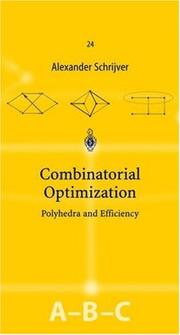
ISBN: 9783540443896 3540443894 Year: 2003 Volume: 24 Publisher: Berlin: Springer,
Abstract | Keywords | Export | Availability | Bookmark
 Loading...
Loading...Choose an application
- Reference Manager
- EndNote
- RefWorks (Direct export to RefWorks)
Combinatorial optimization. --- Optimisation combinatoire --- Combinatorial optimization --- 519.2 --- 519.212 --- Optimization, Combinatorial --- Combinatorial analysis --- Mathematical optimization --- Probability. Mathematical statistics --- Abstract probability theory. Combinatorial probabilities. Geometric probabilities --- 519.212 Abstract probability theory. Combinatorial probabilities. Geometric probabilities --- 519.2 Probability. Mathematical statistics

ISBN: 0691115222 Year: 2003 Publisher: Princeton : Princeton University Press,
Abstract | Keywords | Export | Availability | Bookmark
 Loading...
Loading...Choose an application
- Reference Manager
- EndNote
- RefWorks (Direct export to RefWorks)
Heuristic programming. --- Algorithms. --- Combinatorial optimization. --- Programmation heuristique --- Algorithmes --- Optimisation combinatoire --- Complex analysis --- Computer. Automation --- Discrete mathematics --- Operational research. Game theory
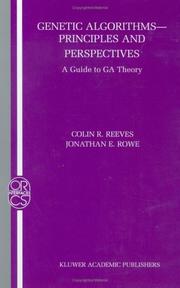
ISBN: 1402072406 9780306480506 0306480506 Year: 2003 Publisher: Boston Kluwer
Abstract | Keywords | Export | Availability | Bookmark
 Loading...
Loading...Choose an application
- Reference Manager
- EndNote
- RefWorks (Direct export to RefWorks)
Genetic Algorithms: Principles and Perspectives: A Guide to GA Theory is a survey of some important theoretical contributions, many of which have been proposed and developed in the Foundations of Genetic Algorithms series of workshops. However, this theoretical work is still rather fragmented, and the authors believe that it is the right time to provide the field with a systematic presentation of the current state of theory in the form of a set of theoretical perspectives. The authors do this in the interest of providing students and researchers with a balanced foundational survey of some recent research on GAs. The scope of the book includes chapter-length discussions of Basic Principles, Schema Theory, "No Free Lunch", GAs and Markov Processes, Dynamical Systems Model, Statistical Mechanics Approximations, Predicting GA Performance, Landscapes and Test Problems.
Genetic algorithms --- Operations Research --- Civil & Environmental Engineering --- Engineering & Applied Sciences --- Computer science --- Artificial intelligence. Robotics. Simulation. Graphics --- GAs (Algorithms) --- Genetic searches (Algorithms) --- Algorithms --- Combinatorial optimization --- Evolutionary computation --- Genetic programming (Computer science) --- Learning classifier systems --- Genetic algorithms.
Book
ISBN: 9782880744465 9782880744595 2880744466 2880744598 Year: 2003 Publisher: Lausanne: Presses polytechniques et universitaires romandes,
Abstract | Keywords | Export | Availability | Bookmark
 Loading...
Loading...Choose an application
- Reference Manager
- EndNote
- RefWorks (Direct export to RefWorks)
Combinatorial optimization --- Linear programming --- Mathematical optimization --- Operations research --- Optimisation combinatoire --- Programmation linéaire --- Optimisation mathématique --- Recherche opérationnelle --- Chaine de Markov --- Recherche operationnelle --- Programmation linéaire --- Optimisation mathématique --- Recherche opérationnelle --- Programmation (mathématiques) --- Operations research. --- Chaines de Markov --- Programmation (mathématiques) --- Markov, Processus de

ISBN: 1281021482 9786611021481 0080522629 0444513507 9780080522623 9780444513502 Year: 2003 Publisher: Amsterdam ; Boston : Elsevier,
Abstract | Keywords | Export | Availability | Bookmark
 Loading...
Loading...Choose an application
- Reference Manager
- EndNote
- RefWorks (Direct export to RefWorks)
In recent years Genetic Algorithms (GA) and Artificial Neural Networks (ANN) have progressively increased in importance amongst the techniques routinely used in chemometrics. This book contains contributions from experts in the field is divided in two sections (GA and ANN). In each part, tutorial chapters are included in which the theoretical bases of each technique are expertly (but simply) described. These are followed by application chapters in which special emphasis will be given to the advantages of the application of GA or ANN to that specific problem, compared to classical techniques, a
Neural networks (Computer science) --- Genetic algorithms. --- GAs (Algorithms) --- Genetic searches (Algorithms) --- Algorithms --- Combinatorial optimization --- Evolutionary computation --- Genetic programming (Computer science) --- Learning classifier systems --- Artificial neural networks --- Nets, Neural (Computer science) --- Networks, Neural (Computer science) --- Neural nets (Computer science) --- Artificial intelligence --- Natural computation --- Soft computing
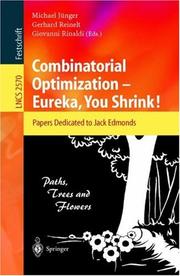
ISSN: 03029743 ISBN: 3540005803 9783540005803 3540364781 Year: 2003 Volume: 2570 Publisher: Berlin: Springer,
Abstract | Keywords | Export | Availability | Bookmark
 Loading...
Loading...Choose an application
- Reference Manager
- EndNote
- RefWorks (Direct export to RefWorks)
Combinatorial optimization --- Edmonds, Jack --- Mathematics. --- Algorithms. --- Numerical analysis. --- Computer science --- Computer graphics. --- Probabilities. --- Probability Theory and Stochastic Processes. --- Discrete Mathematics in Computer Science. --- Algorithm Analysis and Problem Complexity. --- Numeric Computing. --- Computer Graphics. --- Distribution (Probability theory. --- Computational complexity. --- Computer software. --- Electronic data processing. --- Algorism --- Algebra --- Arithmetic --- Automatic drafting --- Graphic data processing --- Graphics, Computer --- Computer art --- Graphic arts --- Electronic data processing --- Engineering graphics --- Image processing --- ADP (Data processing) --- Automatic data processing --- Data processing --- EDP (Data processing) --- IDP (Data processing) --- Integrated data processing --- Computers --- Office practice --- Software, Computer --- Computer systems --- Complexity, Computational --- Machine theory --- Distribution functions --- Frequency distribution --- Characteristic functions --- Probabilities --- Foundations --- Digital techniques --- Automation --- Computer science—Mathematics. --- Mathematical analysis --- Probability --- Statistical inference --- Combinations --- Mathematics --- Chance --- Least squares --- Mathematical statistics --- Risk --- Combinatorial optimization - Congresses
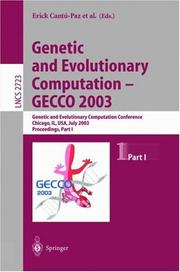
ISBN: 3540406026 3540406034 3540451056 3540451102 Year: 2003 Publisher: Berlin ; New York : Springer,
Abstract | Keywords | Export | Availability | Bookmark
 Loading...
Loading...Choose an application
- Reference Manager
- EndNote
- RefWorks (Direct export to RefWorks)
Genetic algorithms --- Parallel processing (Electronic computers) --- Operations Research --- Civil & Environmental Engineering --- Engineering & Applied Sciences --- Data processing --- Life sciences. --- Computer programming. --- Computers. --- Algorithms. --- Artificial intelligence. --- Application software. --- Evolutionary biology. --- Life Sciences. --- Evolutionary Biology. --- Computation by Abstract Devices. --- Programming Techniques. --- Algorithm Analysis and Problem Complexity. --- Artificial Intelligence (incl. Robotics). --- Computer Appl. in Administrative Data Processing. --- GAs (Algorithms) --- Genetic searches (Algorithms) --- Computer science. --- Bioinformatics. --- Computer Science. --- Bio-informatics --- Biological informatics --- Biology --- Information science --- Computational biology --- Systems biology --- Application computer programs --- Application computer software --- Applications software --- Apps (Computer software) --- Computer software --- AI (Artificial intelligence) --- Artificial thinking --- Electronic brains --- Intellectronics --- Intelligence, Artificial --- Intelligent machines --- Machine intelligence --- Thinking, Artificial --- Bionics --- Cognitive science --- Digital computer simulation --- Electronic data processing --- Logic machines --- Machine theory --- Self-organizing systems --- Simulation methods --- Fifth generation computers --- Neural computers --- Algorism --- Algebra --- Arithmetic --- Automatic computers --- Automatic data processors --- Computer hardware --- Computing machines (Computers) --- Electronic calculating-machines --- Electronic computers --- Hardware, Computer --- Computer systems --- Cybernetics --- Calculators --- Cyberspace --- Computers --- Electronic computer programming --- Electronic digital computers --- Programming (Electronic computers) --- Coding theory --- Informatics --- Science --- Foundations --- Programming --- Algorithms --- Combinatorial optimization --- Evolutionary computation --- Genetic programming (Computer science) --- Learning classifier systems --- Evolution (Biology). --- Computer software. --- Information systems. --- Artificial Intelligence. --- Software, Computer --- Animal evolution --- Animals --- Biological evolution --- Darwinism --- Evolutionary biology --- Evolutionary science --- Origin of species --- Evolution --- Biological fitness --- Homoplasy --- Natural selection --- Phylogeny --- Evolution (Biology)
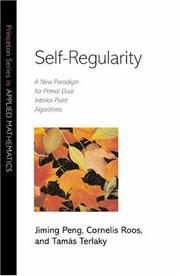
ISBN: 1282087606 9786612087608 140082513X 9781400825134 1400814529 9781400814527 9780691091938 0691091935 9780691091921 0691091927 0691091927 Year: 2003 Publisher: Princeton University Press
Abstract | Keywords | Export | Availability | Bookmark
 Loading...
Loading...Choose an application
- Reference Manager
- EndNote
- RefWorks (Direct export to RefWorks)
Research on interior-point methods (IPMs) has dominated the field of mathematical programming for the last two decades. Two contrasting approaches in the analysis and implementation of IPMs are the so-called small-update and large-update methods, although, until now, there has been a notorious gap between the theory and practical performance of these two strategies. This book comes close to bridging that gap, presenting a new framework for the theory of primal-dual IPMs based on the notion of the self-regularity of a function.The authors deal with linear optimization, nonlinear complementarity problems, semidefinite optimization, and second-order conic optimization problems. The framework also covers large classes of linear complementarity problems and convex optimization. The algorithm considered can be interpreted as a path-following method or a potential reduction method. Starting from a primal-dual strictly feasible point, the algorithm chooses a search direction defined by some Newton-type system derived from the self-regular proximity. The iterate is then updated, with the iterates staying in a certain neighborhood of the central path until an approximate solution to the problem is found. By extensively exploring some intriguing properties of self-regular functions, the authors establish that the complexity of large-update IPMs can come arbitrarily close to the best known iteration bounds of IPMs.Researchers and postgraduate students in all areas of linear and nonlinear optimization will find this book an important and invaluable aid to their work.
Interior-point methods. --- Mathematical optimization. --- Programming (Mathematics). --- Mathematical optimization --- Interior-point methods --- Programming (Mathematics) --- Civil & Environmental Engineering --- Engineering & Applied Sciences --- Operations Research --- Mathematical programming --- Goal programming --- Algorithms --- Functional equations --- Operations research --- Optimization (Mathematics) --- Optimization techniques --- Optimization theory --- Systems optimization --- Mathematical analysis --- Maxima and minima --- Simulation methods --- System analysis --- 519.85 --- 681.3*G16 --- 681.3*G16 Optimization: constrained optimization; gradient methods; integer programming; least squares methods; linear programming; nonlinear programming (Numericalanalysis) --- Optimization: constrained optimization; gradient methods; integer programming; least squares methods; linear programming; nonlinear programming (Numericalanalysis) --- 519.85 Mathematical programming --- Accuracy and precision. --- Algorithm. --- Analysis of algorithms. --- Analytic function. --- Associative property. --- Barrier function. --- Binary number. --- Block matrix. --- Combination. --- Combinatorial optimization. --- Combinatorics. --- Complexity. --- Conic optimization. --- Continuous optimization. --- Control theory. --- Convex optimization. --- Delft University of Technology. --- Derivative. --- Differentiable function. --- Directional derivative. --- Division by zero. --- Dual space. --- Duality (mathematics). --- Duality gap. --- Eigenvalues and eigenvectors. --- Embedding. --- Equation. --- Estimation. --- Existential quantification. --- Explanation. --- Feasible region. --- Filter design. --- Function (mathematics). --- Implementation. --- Instance (computer science). --- Invertible matrix. --- Iteration. --- Jacobian matrix and determinant. --- Jordan algebra. --- Karmarkar's algorithm. --- Karush–Kuhn–Tucker conditions. --- Line search. --- Linear complementarity problem. --- Linear function. --- Linear programming. --- Lipschitz continuity. --- Local convergence. --- Loss function. --- Mathematician. --- Mathematics. --- Matrix function. --- McMaster University. --- Monograph. --- Multiplication operator. --- Newton's method. --- Nonlinear programming. --- Nonlinear system. --- Notation. --- Operations research. --- Optimal control. --- Optimization problem. --- Parameter (computer programming). --- Parameter. --- Pattern recognition. --- Polyhedron. --- Polynomial. --- Positive semidefinite. --- Positive-definite matrix. --- Quadratic function. --- Requirement. --- Result. --- Scientific notation. --- Second derivative. --- Self-concordant function. --- Sensitivity analysis. --- Sign (mathematics). --- Signal processing. --- Simplex algorithm. --- Simultaneous equations. --- Singular value. --- Smoothness. --- Solution set. --- Solver. --- Special case. --- Subset. --- Suggestion. --- Technical report. --- Theorem. --- Theory. --- Time complexity. --- Two-dimensional space. --- Upper and lower bounds. --- Variable (computer science). --- Variable (mathematics). --- Variational inequality. --- Variational principle. --- Without loss of generality. --- Worst-case complexity. --- Yurii Nesterov. --- Mathematical Optimization --- Mathematics --- Programming (mathematics)
| Listing 1 - 8 of 8 |
Sort by
|

 Search
Search Feedback
Feedback About UniCat
About UniCat  Help
Help News
News